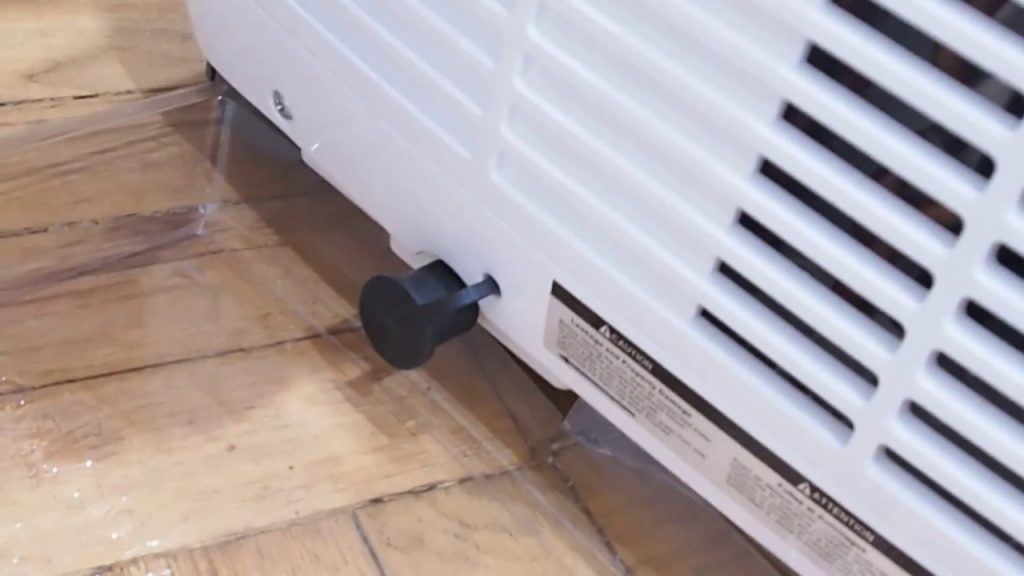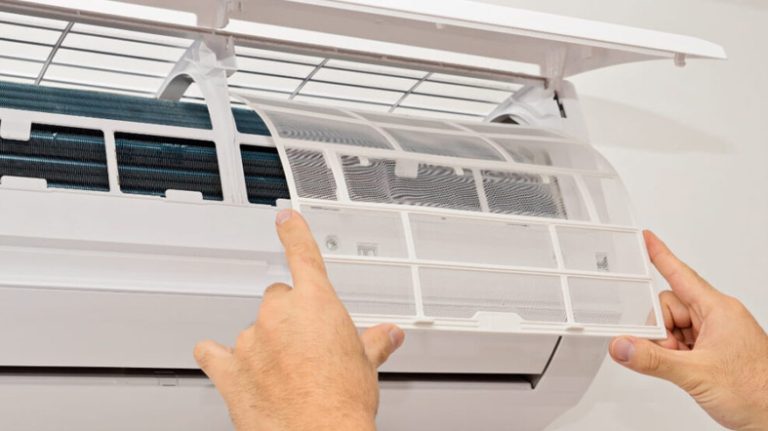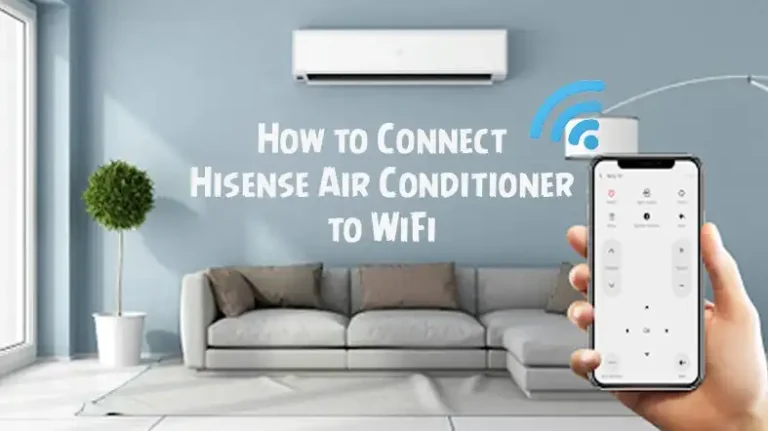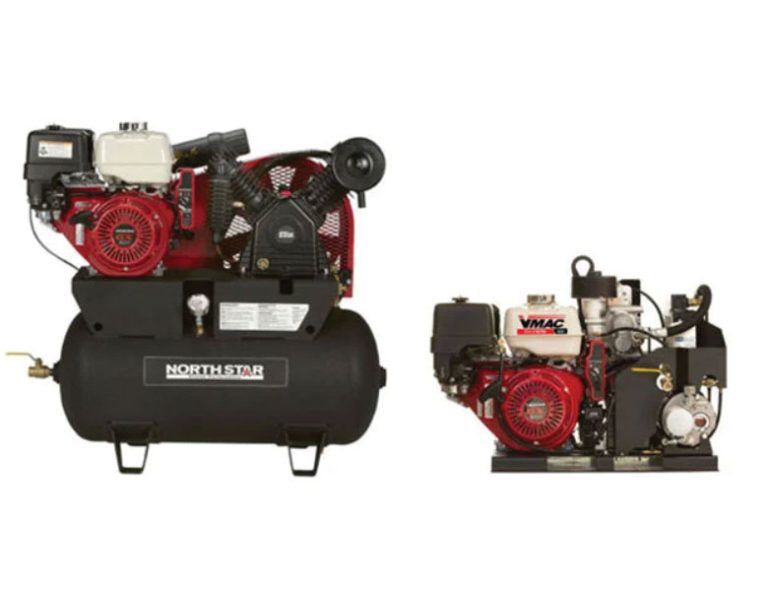[Explained] How to Drain Hisense Portable Air Conditioner
To drain a Hisense portable air conditioner, locate the drain port at the bottom of the unit and attach a drain hose to it. Place the other end of the hose near a suitable drain point, and then release the water by removing the drain cap.
Portable air conditioners are a convenient and effective way to keep your living space cool during the hot summer months. However, as they work to extract moisture from the air, they can accumulate water that needs to be drained regularly.
We will guide you on how to drain a Hisense portable air conditioner properly. By following these simple steps, you can ensure that your unit operates efficiently and avoid any potential leaking or water damage. So let’s get started and learn the correct way to drain your Hisense portable air conditioner.

Need for Draining
Importance of Regular Drainage to Maintain Optimal Performance
- Draining helps to prevent the accumulation of excess water, which can lead to various issues affecting the functionality of the unit.
- When water is not drained regularly, it can create a conducive environment for mold and mildew growth, hindering the air conditioner’s ability to cool effectively.
- Regular drainage helps to maintain the efficiency of the evaporator coils, which are responsible for absorbing heat from the air. If these coils become clogged with water, they won’t be able to perform efficiently, affecting the overall cooling performance of the air conditioner.
- By draining the excess water, you can prevent water leakage, which can damage your floors or furniture. This is especially important if you have carpeted or wooden floors that can sustain major damage if constantly exposed to water.
- Additionally, proper drainage helps to extend the lifespan of your air conditioner, as it reduces the likelihood of potential water-related problems that could lead to costly repairs or replacements.
Consequences of Not Draining The Air Conditioner
The accumulation of excess water can lead to the formation of mold and mildew. These microscopic organisms not only emit unpleasant odors but can also cause respiratory issues and allergies when their spores are released into the air.
If water builds up and overflows from the unit, it can damage your flooring and furniture, leading to expensive repairs or replacements.
Excess moisture also creates a breeding ground for bacteria, which can further compromise the air quality in the room. This can lead to various health problems, especially for individuals with respiratory conditions.
When water is not drained properly, it can cause the evaporator coils to freeze. This impedes the airflow and reduces the air conditioner’s cooling capacity.
Accumulated water can also corrode the internal components of the air conditioner, causing irreparable damage and rendering the unit useless.
Inefficient cooling performance due to poor drainage can result in higher energy consumption, leading to increased utility bills.
How Excess Water Can Impact The Unit’s Efficiency
The presence of water can cause the air conditioner to work harder, leading to increased energy consumption. This can result in higher electricity bills and unnecessary wastage of resources.
Excess water can hinder the proper functioning of the evaporator coils, reducing their ability to absorb heat effectively. This leads to compromised cooling performance, leaving you feeling uncomfortable in your space.
When the air conditioner is unable to cool efficiently, it may run continuously in an attempt to reach the desired temperature. This can put a strain on the compressor, potentially shortening its lifespan and requiring costly repairs or replacements.
Water buildup can obstruct the condensate drain line, causing water to back up into the unit. This can lead to leaks and potential water damage to your surroundings.
If the excess water is not drained, it can also create an environment conducive to the growth of bacteria, mold, and mildew. These microorganisms can negatively impact the air quality in your space and pose health risks to occupants.
Preparing for Drainage
Draining a hisense portable air conditioner is an essential task to ensure its optimal performance and longevity. By properly preparing for drainage, you can avoid potential issues and keep your unit running smoothly.
Gathering the necessary tools and materials
- A shallow pan or container to collect the water
- A towel or rag to catch any spills or drips
- A screwdriver, if required for accessing the drainage area
- A funnel or hose, if needed for directing the drained water
Ensuring safety precautions are in place
- Switch off and unplug the portable air conditioner to prevent any electrical accidents.
- Allow the unit to cool down for a few minutes before handling any parts or attempting to drain the water.
- Follow the manufacturer’s instructions and guidelines to avoid any potential damage or harm.
Setting up a suitable drainage location
- Choose a spot near a drain or sink where the collected water can be easily disposed of.
- Ensure the location is stable and flat to avoid any accidental spills.
Position your portable air conditioner in a way that allows the drained water to flow smoothly and directly into the collection container or drain.
Draining Step-By-Step
Is your Hisense portable air conditioner gathering water and in need of draining? Not to worry, we’ve got you covered with an easy step-by-step guide to help you through the process. By properly draining your unit, you can ensure optimal performance and prevent any water-related issues.
Turning off The Unit And Unplugging It
Before you start the draining process, it’s important to turn off your Hisense portable air conditioner and unplug it from the power source. This ensures your safety and prevents any potential electrical mishaps. Safety first!
Locating The Drainage Port and Removing The Plug
Next, you’ll want to locate the drainage port on your Hisense portable air conditioner. This is typically found at the bottom rear of the unit. Once you’ve located it, remove the plug that covers the drainage port. This will allow the water to flow out freely.
Attaching a Drain Hose to Facilitate Easy Water Removal
To make the water removal process even more convenient, consider attaching a drain hose. This will help direct the water to your desired drainage location without any hassle. Simply connect one end of the drain hose to the drainage port and the other end to your desired drainage spot.
Positioning a Drain Pan or Bucket to Collect The Water
To avoid any mess or water damage, place a drain pan or bucket below the drainage port. This will ensure that the water is collected and contained properly. Make sure the drain pan or bucket is large enough to hold the water without overflowing.
Guiding The Hose Towards The Desired Drainage Location
If you’ve attached a drain hose, guide it toward the desired drainage location. Whether it’s a floor drain, sink, or bucket, ensure that the water can easily flow in that direction. This will prevent any obstructions and optimize the draining process.
Ensuring Proper Angle and Level for Smooth Water Flow
To facilitate smooth water flow, make sure the drain hose is positioned at the proper angle and level. Avoid any kinks or bends in the hose that could hinder the water flow. Ensure that the hose is securely connected to both the drainage port and the drainage location.
Starting The Air Conditioner to Begin Draining
Once you’ve set up the drain hose and ensured the proper angle, it’s time to start the air conditioner. This will initiate the draining process, allowing the water to flow out through the hose and toward the designated drainage location. Sit back and let the air conditioner do its job!
Monitoring The Process for Any Issues or Obstacles
While the air conditioner is draining, it’s important to keep an eye on the process for any potential issues or obstacles. Make sure that the water is flowing smoothly through the hose and that there are no leaks or blockages. This will ensure a successful draining experience.
By following this step-by-step guide, you can easily drain your Hisense portable air conditioner without any hassle. Proper drainage not only ensures efficient performance but also prolongs the lifespan of your unit. Stay cool and dry!
Frequently Asked Questions
How Do I Drain My Hisense Portable Air Conditioner?
To drain your Hisense portable air conditioner, locate the drain plug at the bottom of the unit. Remove the plug and place a shallow pan or dish beneath it to collect the water. Allow the water to drain completely, then replace the drain plug securely.
How Often Should I Drain My Hisense Portable Air Conditioner?
You should drain your Hisense portable air conditioner whenever the water collection tank is full or at least once every few days, depending on the humidity level in your area. Regular draining ensures efficient operation and prevents water overflow.
What Happens If I Don’t Drain My Hisense Portable Air Conditioner?
If you don’t drain your Hisense portable air conditioner regularly, the water collection tank may overflow, causing water damage to your floor or furniture. Additionally, excess water in the unit can lead to reduced cooling performance and potential malfunctions.
Can I Use a Hose to Drain My Hisense Portable Air Conditioner?
No, you should not use a hose to drain your Hisense portable air conditioner. It is designed to be drained manually through the drain plug. Using a hose may cause damage to the unit and void the warranty.
Is It Normal for My Hisense Portable Air Conditioner to Produce Water?
Yes, it is normal for your Hisense portable air conditioner to produce water during operation. This is the result of condensation as the unit cools the air. Regular draining of the water ensures optimal performance of the unit.
Conclusion
To wrap up, keeping your Hisense portable air conditioner drained is essential for optimal cooling performance and preventing any potential damage. By following the simple steps mentioned in this blog post, you can ensure that the condensation from your unit is effectively removed.
Remember to regularly check and clean the drain port, use a suitable container for collecting the water, and avoid overfilling and leakage. Taking these precautions will not only prolong the lifespan of your air conditioner but also help you enjoy its cooling benefits to the fullest.
So, make it a habit to drain your Hisense portable air conditioner regularly, and you can stay cool, comfortable, and worry-free all summer long.

![[Answered & Explained] Can I Put R134A in a R410A AC System?](https://airanswer.com/wp-content/uploads/2023/07/Can-I-Put-R134A-in-a-R410A-AC-System-768x431.jpg)

![Dehumidifier Running But No Water [Answered & Explained]](https://airanswer.com/wp-content/uploads/2023/07/Dehumidifier-Running-But-No-Water-1-768x431.jpg)

